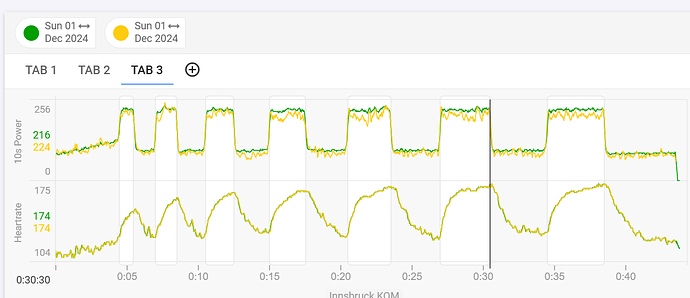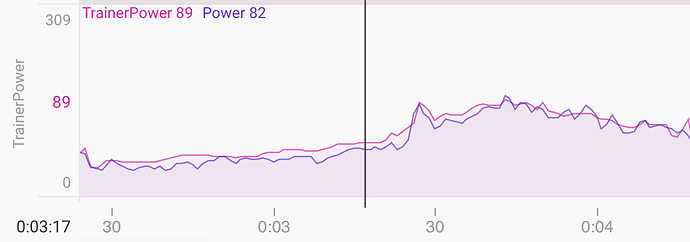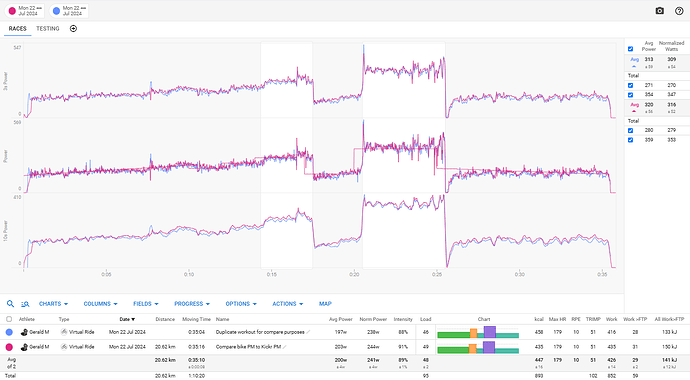A couple of the riders I’m coaching are seeing very significant differences in power readings between their trainers and power meters. Multiple calibration attempts do not lessen the differences between the devices. The variation is enough that they would be in the wrong power zones for a lot of workouts. These overlay graphs are from a rider using a Wahoo Kickr v5 and a set of single-sided Assiamo power pedals. The green lines represent the trainer and the yellow shows the pedals. Based on the heart rate data, I’m inclined to believe that the trainer is correct and the problem is with the pedals. I am going to borrow another set of pedals for some additional testing to see if I can verify that. If the trainer is wrong, they can always use power matching to override it. If the pedals are wrong it’s a bigger problem since these are teenage boys working with very limited budgets who probably cant afford new power meters anytime soon. Any suggestions on how to deal with this issue?
The pedal PMs are especially Noisy (accurate). As they are closet to the feet vs the trainer, there are also some contributions there.
in any case, I too have assiomas and I have been seeing discrepancies between it and my trainer. (Typically trainer power is pretty solid and smooth, so this works out to it having more stable data)
eg:
This is with powerMatching on my assioma vs Trainer
If these are ´wheel-on´ trainers, make sure that they inflate the tire to the exact same pressure each time.
Lower pressure = more resistance.
Both kids are using direct drive trainers so that’s not the source of the discrepancy.
Is the problem consistently the same across all power levels?
Most manufacturers will claim a +/- 1-2% accuracy. Assume 2%, which means it could be 4% if the trainer is +2% and pedals -2%. You show a screenshot of 224 vs 216 which is 3.7% difference. Besides the drivetrain loss, the trainer uses a power curve based on the speed of the spinning hub.- Then apply the minor losses between trainer and pedals, and then a 2-4% variance from perceived accuracy.
So accuracy is secondary if the reading is consistent and you can use adjusted numbers, eg. if the trainer is 4% too high, then L2 would be 52-71% of FTP, and L3 would be 72-86%, etc.
If consistent use the indoor FTP for indoor workouts.
Intervals has a setting for Indoor and Outdoor FTP.
The difference in average power for a typical ride is usually around 12 to 15 watts. The gap gets much larger as the power output increases. I have not looked at the percentage difference at different power levels.
If they have single side power meter, that could also induce differences up to 7-8%.
I compared my Assiomas with a 1st Gen Tacx Neo at several gear ratios but the same cadence, and I found there was a relationship between gear and the difference between the two power meters.
As I recall, the difference was greatest in 53x13 and least in 53x17 (I only tested between 53x13-17).
My conclusion is that it is all very complicated!
Do I need to check the Indoor setting on their planned workouts for that to work?
Yes. you do.
yeah, it happens not only with the kickr, or kickr v5, or assioma’s. i’ve seen this accross trainers and also crank arms pms.
they measure power in very different ways and there’s something about the pedals and the dynamics of the trainers, probably about the way resistance is applied over the length of pushing the pedals that they don’t work well… that’s a guess.
and i mean this because the rpe and numbers outside with those pms change. usually you’ll see better numbers.
i use the trainer’s indoors as source, since the rpe/power seems more aligned with the pedals outdoors. they never felt the same, but are close enough to do the same sessions.
See if you can borrow a set of dual sided assioma’s or similar and see if there is power imbalances between the legs. I weaker left leg will show as reduced power relative to the trainer (assuming the trainer is accurate). I have an average 7% discrepancy between my Assiomas (dual) and my trainer at intensities up to threshold, (It evens out above threshold ). I believe Trainer Day has the ability to mark up or down the reported power, so any difference can be broadly accounted for. I use an old Xert app on IoS which also has this ability. I think that the new app has lost this ability so I’ve not updated it for a couple of years in case it has.
My leg imbalances are a lot worse on the turbo than outside. I think maybe its something to do with the way bike moves around outside whereas inside it obviously doesn’t despite me having a rocker plate.
My L/R balance is ~54/46 when cycling low power (Z1 to low Z3).
At threshold the discrepancy disappears almost completely and both legs contribute same power.
This means that with a single sided (L) power meter, my endurance Power would be over-estimated by ~8% while threshold would be OK.
Hi Chris,
Regarding Wahoo trainers, I found that they underreported power compared to my Assioma Duo power pedals. I was able to pretty much fix this by doing a factory spindown calibration on my Wahoo trainer.
In my experience, it is best to perform with the unit warm. Zwift Insider has a well written article on how to do it.
I have been observing the same issue on multiple devices. I’ve been comparing it with my stages PMs with 30-34t chainring as well as with my Vector 3 pedals with 52/36t road crankset. The conclusion I’ve drawn is that the discrepancy depends on at least 2 factors. The biggest is the chainring to sprocket ratio (and i can’t really tell smaller or bigger is better) and I see some difference when using “game” mode in zwift vs ERG mode. I found it impractical and difficult to train with trainer’s PM as a source - especially close to the threshold.
I have also suspected for some time that the measurement of my Wahoo Kickr shows much lower values compared to my Garmin Rally RS200. The RS200 measures on both pedals and normally I have a maximum deviation between the right and left side of ± 1%. During a supervised FTP test in the gym a fortnight ago, I achieved an FTP value of 257 watts, with the last two minutes riding at around 350 watts. Based on my values on the Kickr, I was extremely cautious about the wattage, and I probably could have achieved an even higher FTP value. Last Sunday I repeated the FTP test on my Kickr when I was rested. It has to be said that the 4DP Full Frontal Test is structured slightly differently and by the start of the 20-minute phase of determining the FTP value you have already reached a certain level of exhaustion. Nevertheless, I was extremely shocked by the result of 212 watts, as the perceived resistance was far higher than the perceived resistance in the gym and at lower values. With the values achieved on the Kickr, I naturally find it difficult to control my training outside on my road bike.
FWIW, here is the comparison between a 4iiii (left side only) PM and a Kickr Core.
Shows raw power as well as 3s, and 10s averages.
My L/R balance varies between 48/52 to 50/50 depending on my concentration levels. The more focussed I am, the closer it gets to 50/50. It seldom goes right of 50/50 (infact I don’t recall ever seeing it 51/49). So a left side power meter could be under reading by 0-2%.
Variance shows the 4iiii is 4% lower than the Kickr.
I have the same issue on a Kickr Core with a Stages Power Meter on the bike. I posted similar questions on various bike-forums and never found a solid solution. Except for this advice:
Ignore it. Meaning, make an FTP-test using the trainer only, and use that result as benchmark for the training. And make sure to include RPE in your training.
As long as the power is consistent from one training to another, it really isn’t important if the numbers are correct.



